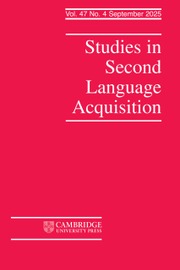Article contents
THE RELEVANCE OF INFORMATION ORGANIZATION TO SECOND LANGUAGEACQUISITION STUDIES
The Descriptive Discourse of Advanced Adult Learners ofGerman
Published online by Cambridge University Press: 10 February 2001
Abstract
The present cross-linguistic study deals with the relevance of principles of informationorganization in adult second language acquisition. It looks at typological features of informationstructure that allow speakers to organize and shape the flow of information when carrying outcomplex tasks, such as giving a description, and pinpoints factors that lead to the selection oflinguistic form. At the focus of our attention are means used in reference introduction, such asexistential and locational constructions, the morphosyntactic forms of expressions applied inreference maintenance, and word order. The cross-linguistic comparison shows that the optionsfound in the expression of these functions in German, English, and Romance languages (French,Italian, and Spanish) follow distinct patterns in that the linguistic means used reflect unifyingprinciples of a typological nature. These principles are perspective driven and are associated withpatterns of grammaticization. Structures in language that reflect core principles in informationorganization may be difficult to acquire because learners have to recognize clusters ofform-function relations that range over different domains. The nature of the analyses required isdescribed for learners of German with English and Spanish as their source languages. Theinterlanguages (ILs) of these speakers show a high degree of compatibility with German informal syntactic terms and are near native in many respects, but the levels at which the IL andtarget language diverge can be linked to fundamental principles of organization underlyinginformation structure. Although the stage of acquisition is advanced, the languages still retaincore principles in information structure typical of those found for English and Romancelanguages.
Information
- Type
- Research Article
- Information
- Copyright
- © 2000 Cambridge University Press
- 55
- Cited by

